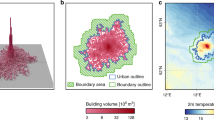Abstract
Two techniques are analysed to derive mean street width and mean building width from morphological data of real cities: one based on a two-dimensional simplified morphology, and the other based on a three-dimensional regular simplified morphology. For each simplified morphology (two-dimensional and three-dimensional), the sky-view factors (street-to-sky) are computed and compared with the sky-view factors derived from the real morphology for selected districts of three European and two North American cities. The two-dimensional simplified morphology reproduces the real sky-view factors better than the three-dimensional morphology. Since many urban canopy parameterizations represent the city using simplified morphologies, this can be useful information for the derivation of input parameters for urban canopy parameterizations from real morphological data.
Similar content being viewed by others
References
Harman IN, Belcher SE (2006) The surface energy balance and boundary-layer over urban street canyons. Q J R Meteorol Soc 132: 2749–2768. doi:10.1256/qj.05.185
Kanda M, Kawai T, Kanega M, Moriwaki R, Narita K, Hagishima A (2005) A simple energy balance model for regular building arrays. Boundary-Layer Meteorol 116: 423–443. doi:10.1007/s10546-004-7956-x
Kanda M, Kawai T, Nakagawa K (2005) A simple theoretical radiation scheme for regular building arrays. Boundary-Layer Meteorol 114: 71–90. doi:10.1007/s10546-004-8662-4
Kondo H, Genchi Y, Kikegawa Y, Ohashi Y, Yoshikado H, Komiyama H (2005) Development of a multi-layer urban canopy model for the analysis of energy consumption in a big city: structure of the urban canopy model and its basic performance. Boundary-Layer Meteorol 116: 395–421. doi:10.1007/s10546-005-0905-5
Kusaka H, Kondo H, Kikegawa Y, Kimura F (2001) A simple single-layer urban canopy model for atmospheric models: comparison with multi-layer and slab models. Boundary-Layer Meteorol 101: 329–358. doi:10.1023/A:1019207923078
Martilli A, Clappier A, Rotach MW (2002) An urban surface exchange parameterization for mesoscale models. Boundary-Layer Meteorol 104: 261–304. doi:10.1023/A:1016099921195
Masson V (2000) A physically-based scheme for the urban energy budget in atmospheric models. Boundary-Layer Meteorol 94: 357–397. doi:10.1023/A:1002463829265
Oke TR, Johnson GT, Steyn DG, Watson ID (1991) Simulation of surface urban heat islands under ‘ideal’ conditions at night. Part 2: Diagnosis of causation. Boundary-Layer Meteorol 56: 339–358. doi:10.1007/BF00119211
Ratti C, Di Sabatino S, Britter R, Brown M, Caton F, Burian S (2002) Analysis of 3-D urban databases with respect to pollution dispersion for a number of European and American cities. Water Air Soil Pollut Focus 2: 459–469. doi:10.1023/A:1021380611553
Author information
Authors and Affiliations
Corresponding author
Rights and permissions
About this article
Cite this article
Martilli, A. On the Derivation of Input Parameters for Urban Canopy Models from Urban Morphological Datasets. Boundary-Layer Meteorol 130, 301–306 (2009). https://doi.org/10.1007/s10546-008-9345-3
Received:
Accepted:
Published:
Issue Date:
DOI: https://doi.org/10.1007/s10546-008-9345-3




